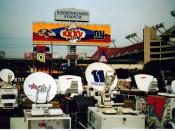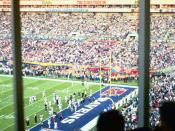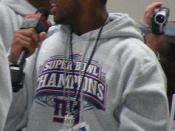Every year, for the past 35 years, on the last Sunday in January a football game is played. It involves two football teams "" the bast of the best, for that game season. This past January 28, 2001, it was a game between the Baltimore Ravens and the New York Giants, Super Bowl XXXV. A friend of mine invited me to a party for this specific game and although I normally don't watch football games (because I have little interest in them), I decided to be open-minded and accepted his invitation, hoping it might be a positive experience. But after watching the game I was told that it had been a terrible one. The Ravens dominated the Giants with a score of 34 to 7. There wasn't too much excitement involved. My experience did not seem to be positive at immediate glance, but it did prove to be enlightening.
By observing the football game, I was able to realize that the practice of the Super Bowl contributes to the making of a specific kind of community.
Upon arriving at the Super Bowl XXXV party I felt a huge sense of gathering between myself and everyone else. This sort of gathering had been going on for 35 years. It was a ritual, where people would come together and share a common interest. Everyone was at this party for a reason; they all wanted to be there. The main purpose for having this party is to watch the football game. They all had an interest in the Super Bowl. This was what brought them together: together in a literal sense, that their bodies were all in the same room; and together in a psychological sense, that they all shared a common interest, they had that connection that gave them an easier basis to bond. It is this process of coming together that forms a community. A community is "a group of people living together as a smaller social unit within a larger one, and having interest, work, etc. in common." (Webster's New World Dictionary) The audiences of each Super Bowl have, in common, an interest, which makes them a community. With the occurrence of Super Bowl XXXV a community is being built upon.
Before the game had even started, the cooler full of beer was placed right next to the couch. One thing that seems to be necessity at all Super Bowl games is beer. Why is this? It seems to create a more relaxed environment. Since the Super Bowl is seen as a social gathering, alcohol becomes associated with social interaction. This could be a main reason why people tend to arrange most social gatherings with alcohol, because it is associated with having group fun. Those that watch the Super Bowl "" this community "" would consider it a necessity to have alcohol at gatherings and celebrations.
There were cheerleaders along the sidelines of the football field. A question that I would often ask myself, through the course of the game, was: is there any significance in the existence of cheerleaders? Every now and then they would be shown enthusiastically encouraging their team. They wore tight tank tops and skirts, and their colors corresponded with that of their team. Most were attractive blondes who were thinner that average. They seemed to portray a common male fantasy: attractive women in skimpy outfits, jumping around and not really having much relevance. They are there so that sex can be incorporated into the game. When I see these women, I see images of sex toys. "These images help construct for their intended audience ideas about those who are defined as outside that audience," (O'Barr, 45) most particularly, women. In Representations of Others, Part I, O'Barr explains how different cultures are inaccurately portrayed in advertisements. These advertisements wrongly create stereotypes of others by trying to sell products. Similarly, the cheerleaders of the Super Bowl are women, and so they represent women. Therefore, women as a whole, are being negatively represented to this audience as sex toys and objects. This is how the audience would from negative stereotypes about women. Since the audience is a community, in itself, this community would view women, in general, as objects.
When I asked my friend why there aren't ever any women in the game, he replied "guys don't want to see women play [football]." It seems as though they think bringing women into the game reduce the amount of excitement it has. Why? Well, men, in general, are naturally stronger than women "" it's a biological fact that can't really be changed. Buys don't want to see women play football, they want to see strong men play. They want to see these male athletes compete against one another in trying to display their ability and strategy. They want to see those of the same sex "" those representing them "" gain that respect and compete for that respect, because respect leads to power and control. This is something most men do, instinctually, find ways to exert their control and affirm their power. This goes back to the old-fashioned ideals of Gender Roles. They still linger, in a subtle manner, in most our minds. These sorts of ideals are similar to those of the Songhay people in Nigeria. "[The family of Ishi] not only enjoyed regular infusions of cash [from Ishi], but could rely on the industrious Khadija to look after all of their domestic needs." (Stoller, 41) The male is in the position of power (he supports the family "" the family relies on him), and the female is the yielding one (the submissive-type, domestic caregiver). These games where men are at a competition for power, are examples of how the old-fashioned concepts of Gender Roles are being illustrated, today. This would contribute to the community's views of the relationships between the sexes.
It's a known fact that, generally, women aren't as enthusiastic about the Super Bowl as men are. I was constantly reminded of this because I was the only girl at this Super Bowl XXXV party. So I asked one of the guys why football held so much more of an interest for guys that it did for girls. "Most girls don't understand the game, but I do and that makes it easier for me to enjoy it." This is a similar viewpoint that born-again believers have toward non-believers, according to Susan Harding. "Born-again believers say that unbelievers cannot understand their faith. (Harding,39). I, personally, had a difficult time following the game. I remember when the announcer would describe and re-cap what was occurring the game and I was didn't understand many of the terms he used. I was a perfect example of those who do not understand the game. I wasn't familiar with the discourse of the game. I hadn't experienced watching enough games to be considered a "fan of football", where one understands he game, understands the discourse, and has seen the game many times. Like the imaginary line between the Believers and the non-believers, the game separates those who understand the game and those who do not. In most cases, those who don't watch and don't know the game have a negative attitude toward those who do, which is very parallel to the relationship between Christians and non-Christians. Harding would argue that football is a system of faith. Her theory is that language forms a belief and that belief is entered when the language of the belief is acquired. Football has it's own language that requires an understanding in order for an individual to enjoy the game. Here, the Super Bowl can be considered religion. Where this community's views and faith are based upon football, which is different than typical religions.
The Super Bowl has been an ongoing ritual for 35 years, now. It is a tradition created by this pattern of rituals. It is a gathering that brings generations and people together. This is how a community is formed. A community, in this instance, where women are represented as sex objects and men are represented as strong, power figures. In this community the old-fashioned Gender Roles still linger and alcohol is acceptable and widely encouraged. This is a community where the Super Bowl is the formal religion.






